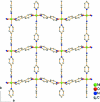Poly[bis-(μ(2)-4,4'-bipyridine)bis-(3-nitro-benzoato)cobalt(II)]
- PMID: 21578067
- PMCID: PMC2971117
- DOI: 10.1107/S1600536809039786
Poly[bis-(μ(2)-4,4'-bipyridine)bis-(3-nitro-benzoato)cobalt(II)]
Abstract
The hydro-thermal reaction of cobalt nitrate with 4,4'-bipyridine and 3-nitro-benzoic acid lead to the formation of the title complex, [Co(C(7)H(4)NO(4))(2)(C(10)H(8)N(2))(2)](n). In the crystal structure, the Co(II) atoms are coordinated by two terminal carboxyl-ate anions and four 4,4'-bipyridine ligands within slightly distorted octa-hedra. The Co(II) atom and one of the two independent 4,4'-bipyridine ligands are located on a twofold rotation axis, while the second independent 4,4'-bipyridine mol-ecule is located on a centre of inversion. One of the two rings of one 4,4'-bipyridine ligand is disordered over two orientations and was refined using a split model [occupancy ratio 0.68 (2):0.32 (2)]. The Co(II) atoms are connected by the 4,4'-bipyridine ligands into layers, which are located parallel to the ab plane.
Figures


References
-
- Biradha, K., Seward, C. & Zaworotko, M. J. (1999). Angew. Chem. Int. Ed.38, 492–495. - PubMed
-
- Brandenburg, K. (2009). DIAMOND. Crystal Impact GbR, Bonn, Germany.
-
- Bruker (2008). SADABS, APEX2 and SAINT Bruker AXS Inc., Madison, Wisconsin, USA.
-
- Kitagawa, S., Kitaura, R. & Noro, S. (2004). Angew. Chem. Int. Ed.43, 2334–2375. - PubMed
-
- Sheldrick, G. M. (2008). Acta Cryst. A64, 112–122. - PubMed
LinkOut - more resources
Full Text Sources
Research Materials
Miscellaneous
